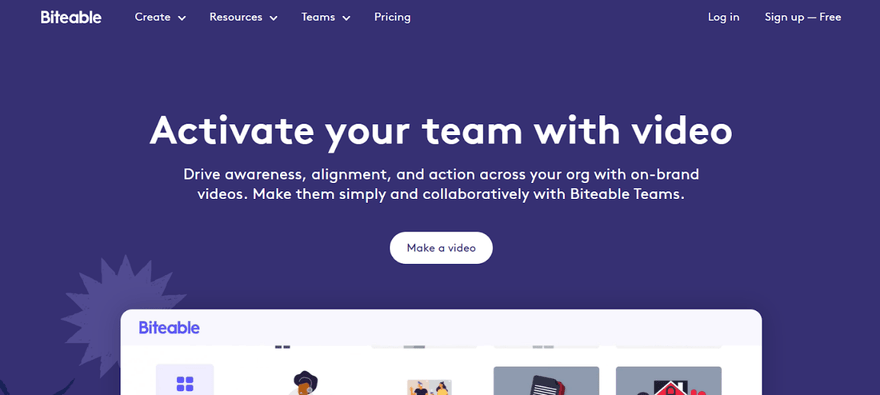How to Create a Video Marketing Strategy
If you click to purchase a product or service based on our independent recommendations and impartial reviews, we may receive a commission. Learn more
Unless you’ve been living under a rock for the past year or so, you’ll probably be aware that video marketing is having a moment. Although it’s by no means a new marketing strategy, a combination of factors has propelled it back into the limelight.
Long story short, if you aren’t doing it yet, you should be! However, this is often easier said than done. Don’t worry though! We’re here to give you a helping hand, on everything from getting started to video optimization. The first step to video marketing success is to build a video marketing strategy, and below, we’ll show you exactly how to do just that. We’ll even throw some handy video marketing tips in along the way, too!
Why Should You be Using Video Marketing?
With the popularity of YouTube and TikTok, the rise of social media, and an increase in mobile usage, the conditions for video marketing success are just right.
Not only that, but an increase in free or affordable online tools has made this marketing channel accessible to smaller businesses as well as their larger competitors. This means everyone can get a piece of the pie!
But is it worth your time and investment? The answer to this is a resounding yes. Take a look at the top reasons for including video in your content marketing plan:
1. Video Marketing Boosts Conversions
When you boil it down, we’re all in this business to make money, right? Which is why video marketing should be high up on your priority list. A study carried out by Wyzowl found that 78% of marketers attributed a rise in sales directly to video marketing, whilst 86% said it had increased traffic to their website.
The numbers don’t lie – including video in your marketing strategy isn’t just about making things look pretty.
In addition to this, videos encourage customers to spend longer on your pages and also help them to better understand your services and products. Both of these things give you an increased chance of scoring a conversion. Plus, a greater understanding of what you can offer reduces the risk of dissatisfied customers in the long run!
2. Helps With Brand Building and Storytelling
Customers love a brand that has a good story behind it. A compelling narrative helps to build a stronger connection with your users, as well as increase trust and legitimacy.
Part of this comes from the fact that you can inject more of your personality into videos. Sure, you can write a bunch of witty copy, but it’s not quite the same as seeing the face behind the brand and hearing them talk with enthusiasm about what they offer.
In this way, video can humanize your business. You’d be surprised by how many people value the sight of a real person, and the impact that has on their interactions with your brand.

3. Video Appeals to Different Types of Visitors
As the world around us has changed and developed, so, too, has the way we consume information. We’re living in a time of instant gratification, where our attention span lasts for mere seconds and you can bet your bottom dollar that your potential customers aren’t going to be hanging onto your every written word.
As well as being visually more appealing, absorbing information via video requires minimal effort, so even the most casual of visitors are likely to engage with your content.
It also targets those customers who digest details better through watching rather than reading, allowing you to appeal to a wider audience.

The increased use of mobile devices means that most people expect to watch videos as part of their purchasing journey. This is also partly due to the prevalence of video across social media platforms such as Instagram and TikTok.
These trends have bred a generation that wants to see your brand and products in action before they commit and make any buying decisions.
4. Video Has Great SEO Benefits
Once again, video proves that it has more to offer than just its aesthetic advantages – this time in the form of great SEO benefits. Not only does it increase the amount of time your visitors spend on your pages, but it also helps to enhance your authority in the eyes of Google.
This is because video increases the quality of your content and adds relevance, which is something that search engines are also looking out for when deciding their rankings.
Plus, people are more likely to share videos than written media. This results in more backlinks to your website, which boosts your credibility. If lots of people are looking to you as an expert on a certain topic, Google is more likely to sit up and take notice, too.
If you need any further evidence of this, just take a look at the search engine results pages. Google often displays videos above page links.
That means that your potential customers are going to be seeing videos way before they get to your carefully curated meta titles and descriptions. It’s worth having a video up there to counter this, and to get your website as close to the top as possible!

Advice From the Experts
Video marketing plays an essential part in your brand storytelling. It's an excellent way to demonstrate the personality of your brand while creating a personal connection with your audience. People love getting to know the people and story behind their favorite products. And regularly posting short-format videos to your social media feed highlighting your brand's inception, mission, values, products, CSR initiatives, and everyday gains weaves a compelling narrative that takes your audience along on the journey.
Further Reading
Interested in the benefits of digital marketing? Take a look at our 11 Digital Marketing Top Tips to see how you can get the most out of your marketing campaigns.Email marketing is a powerful tool too. Learn How To Embed Videos In Emails to bring your video content to your email subscribers!
What Types of Videos Can You Create?
Before you begin building your video marketing plan, it’s a good idea to think about what type of videos you want to produce. You might think that all videos are effectively the same, but they all have different styles and purposes, and one type might be better for your business over another.
Advice From the Experts
Think about what kind of videos will be most engaging and informative for your target audience, and produce content that is genuinely worth watching. Once you have a few strong pieces in your portfolio, you can then begin to expand your scope and produce more videos regularly. Quality should always be your main priority in video marketing - so make sure not to sacrifice it in the pursuit of quantity!
Take a look below at some of the types of videos you can use in your video marketing strategy:
- Commercials – Television commercials have been around since the 1950s and they’re still going strong today. Nowadays, however, they’re not just restricted to television, and you’re likely to see lots of them popping up on social media platforms, too.
- Social Videos – In addition to commercials, social media platforms often have their own video-sharing capabilities. Both Instagram and Facebook use Stories and host live recordings, while TikTok is built entirely around sharing videos.
- Explainer and Demo Videos – Explainer and demo videos are ideal for educating customers as well as showing your products or services in action. They’re suited to both your website and your social pages and will go a long way to secure those extra sales.
- Product Videos – Online shopping has long been the norm, but increasingly, consumers aren’t happy to commit to a purchase just based on a few photos. They want to see products being used and modeled so they can decide if they want to invest.
- Testimonials – There’s nothing quite like a bit of social proof. Reviews go a long way to convincing potential customers to take a chance on your products. Using video to show these testimonials makes them more engaging and easier to digest.
- Brand Videos – These videos are all about storytelling. They do the very important job of helping your visitors connect and build trust. Plus, they’re great for adding some extra personality to your business.
Of course, this list isn’t exhaustive – there are tons of other ways you can use video in your content strategy. Plus, as the marketing landscape changes, so does the way businesses are using video to promote their brands and products.
Have fun with the videos you’re planning to create, and don’t be scared to get creative. Innovation often leads to the best kind of success!
Find Out More
- How To Start a Vlog: Learn vlogging tips and tricks in our full guide!
- TikTok Ideas for Businesses: Get inspiration for making TikToks
How to Create a Video Marketing Strategy
Before you actually start your video marketing creation, you’ll need to build your strategy first.
Why? Well, you wouldn’t set off on a long, unfamiliar journey without a map, would you? It’s the same when you begin a new digital marketing tactic. Your strategy will determine your course and keep you on track to reaching your goals.
Below, we’ll take you through the six key steps to creating your own strategy and help you on your way to video marketing success.
1. Identify Your Audience
Like with anything, you’re more likely to see success if you have a clear idea of who and what you’re targeting with the videos you’re creating. As much as we’d love to tell you that you can appeal to everyone, there’s going to be a particular group that your product will resonate with more.
Top Video Marketing Tip!
To help you get a better idea of what your target audience wants, why not create some user personas? These are semi-fictional profiles that detail the main characteristics of your ideal customer. They can help your audience become less of an abstract idea and more like real people so you can put yourself in their shoes.If you want to see what a good user persona looks like, check out these 6 top persona examples.
Once you’ve identified what this group is, you’ll also find it much easier to decide on which kinds of videos you need to create. This is because certain types of people will spend their time in different places. There’s no point creating a ton of videos for TikTok if your audience prefers Facebook!

By having a clear idea of your audience and their preferences from the beginning, you can keep a much narrower focus during video production. This means the whole process will be much more streamlined.
2. Determine the Goals of Your Videos
It might sound obvious, but make sure you know why you’re making these videos.
As we mentioned above, there are a ton of different video types out there, all of which are designed for a specific purpose. It’s key that you know what you want to achieve with your videos, so you pick the right types to focus on.
It’s easy to make the mistake of trying to do too much, which is a risk you run if you don’t set out your ultimate aims at the beginning.
That’s not to say that you only have to choose one type of video! In fact, different parts of your funnel will call for different forms of video. However, it’s best to know this in advance, so that when you get to the planning stage, later on, you’ve got a good idea of how you’re going to split your budget and resources.
Advice From the Experts
Target every stage of the marketing funnel with your video content. Some brands treat video like it only serves one purpose, or they cram all of their marketing goals into a single video. Maximizing video potential means developing a strategy that highlights three steps in the customer journey: awareness, engagement, and purchase.
When it comes to deciding on your goals, it’s also a good idea to split them into long-term and short-term aims. Not only will this make it easier for you to structure your strategy, but it’ll also help the task to feel less overwhelming. If you’ve planned in lots of little steps, you’ll feel like you’re making more progress towards achieving your ultimate long-term goal.
Once your strategy gets underway, this approach will also help you keep your videos cohesive. This is because you’ll have plenty of points at which you can check in to make sure your tone and messaging are on brand and working towards their desired purpose.
3. Decide a Timeline and Budget
This is a big one! If you’re a practical planner, it’s likely that the very first thing you thought about was how long your video strategy might take and how much it’s going to cost you.
Budget
The good news is that, nowadays, making videos isn’t as costly as you might imagine. Don’t get us wrong – you’ll have to make some kind of investment if you want to produce quality videos – but you won’t have to ship in state-of-the-art cameras and expensive film crews to get going!
Advice From the Experts
In a mobile-first world, you have less time to grab people. Attention spans are shorter than ever, but video is great for showing vs telling for maximum impact. Video does not have to be expensive, it just needs to educate, inform or entertain in a way that is timely and relevant so that people find it useful and ideally pass it along. The key is to connect with your audience on an emotional level. Sometimes the cheapest ideas have the most impact.
There are plenty of ways to get recording nowadays, whether you want to use an affordable online software like Loom, or just shoot directly from your smartphone.

However, it does pay to spend a chunk of time in the editing room, polishing up your videos so they have that professional sheen. Make sure that when you’re outlining your total spend, you factor this in.
Heads up!
Although it is possible to create video marketing assets without breaking the bank, it’s also important to be realistic.If you don’t mind the end result having a “home-made” feel to it, that’s great, but if you’re expecting Hollywood standard, you’re going to need to spend more upfront. This applies especially to hiring additional resources or equipment.
Make sure you’re really clear on your aims and what you can plausibly achieve with what you have available to you – it can be easy to get swept away in the excitement of it all!
Timeline
Once you’ve established your budget, it’s time to decide your timeline. This should cover two things: how long it will take to get your video marketing up and running, and how long you want your video marketing campaign to run.
The latter is somewhat determined by your budget because you can only keep going as long as you have the cash to produce and edit new videos. The first is a bit more difficult to pin down. We’d recommend using your short and long-term aims to decide how much time you have to get things off the ground.
4. Choose the Platforms You’re Going to Broadcast On
There are plenty of video-friendly platforms out there, and there’s a good chance you won’t be able to broadcast on all of them. It’s time to choose which ones you’re going to target.

As we mentioned earlier, this will largely depend on your audience and where they prefer to spend their time. But there’s more to it than that – you’ll also need to make sure that each video is specifically optimized for that specific platform.
This is because every platform has its own algorithms and preferences that will determine your video’s success:
- YouTube: You’ll need to buff up your SEO – integrate keywords into your descriptions and titles to increase your views.
- Facebook: prefers a shorter video, formatted within a square.
- Twitter: isn’t known for lengthy clips, so focus on keeping things well under a minute, and make sure you get popular hashtags involved.
- Instagram: Spend time on your thumbnail image. Make it as attractive as possible, because this is what you’ll want people to pick out from a sea of reels.
There are a ton of video marketing tips we could reel off here, but the bottom line is that it’s important to do your research. Make sure you know what your target platform wants, and then deliver it.
Further Reading
Are you planning to focus on social media? Make sure you read our guide to Creating a Social Media Strategy before you get started!5. Develop Video Content Ideas
Now we get to the fun bit: deciding on your video messaging and planning your videos. This is where you can get creative. Write those witty scripts, create those colorful storyboards – do anything that’s going to help you create visually compelling videos that your customers are going to love!
Hey, you might be thinking, isn’t it a bit late in the day to be thinking of what you want your videos to do and say?
Actually, although it’s good to have a vague idea of what you want your messaging to do, we think that leaving this until the end is a good idea. That’s because all of the hefty planning has been done and you know what your creative constraints are.
As exciting as this part is, you still need to be realistic. For example, how do you know you’ve got the cash to hire Tom Cruise if you haven’t done your budget? It’s best to work out all of the details before your big ideas get away from you.
This also applies to the platforms you’re planning to use. It’s important to know which formats they like best before you whip your camera out and start recording reams of film that you’ll most likely never use.
Plus, just because this might be one of the last things you do doesn’t mean you can’t change your mind further down the line. As with all digital marketing strategies, flexibility is key. If something isn’t working, change it.
Sure, you might need to make some tweaks to your budget and timeline, but being reactive to the wider context is important if you want to see long-term success.
Advice From the Experts
A top tip for an effective marketing strategy is to speak to other departments when planning. Ask your sales team, for example, what questions customers have or what misunderstandings they encounter when talking to people about your products. You can then produce videos that specifically demonstrate these things to people pre-empting their questions and providing precisely the information they want.
6. Identify Metrics to Track Performance
This is it – you’re almost there! All of the hard work is done and the only thing that’s left is to launch.
Before you get too carried away, though, there’s one small but important job to complete: choosing which metrics you’re going to use to track your videos’ performance.
Whether that be clicks, viewing time, social shares, or comments, the data you gather from these metrics will help you to understand the effectiveness of your campaign and the overall return on investment (ROI). It’ll also most likely determine whether you continue with video marketing in the future.
Top Video Marketing Tip!
Each platform will come with its own set of in-house metrics that you can use to measure success. YouTube, for example, has a whole dashboard full of numbers and graphs.Don’t be afraid to use your own metrics, though – there might be something important to you that a particular platform doesn’t cover. Plus, this makes it easier to evaluate the success of your videos as part of a wider omnichannel strategy.
Aside from this, though, it’ll help you highlight areas for improvement the next time around. No one gets it right the first time (unless you’re incredibly lucky!) so learning from previous mistakes will make your strategy more robust in the future.
Further Reading
Want to see the return on investment for other key digital marketing strategies? Check out our guide to Digital Marketing ROI Statistics.How to Create a Video Marketing Strategy: Summary
Summary
Identify Your Audience
Determine the Goals of Your Videos
Decide a Timeline and Budget
Choose Your Platforms
Develop Video Content Ideas
Identify Metrics to Track Performance
And that’s it! Once you’ve created your video marketing strategy, don’t forget to tell us all about your experiences in the comments below.

Leave a comment